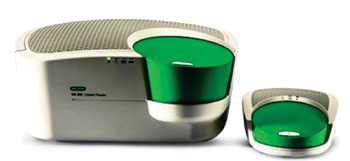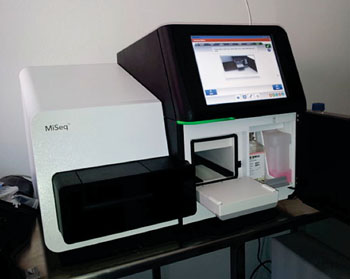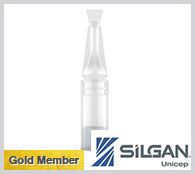Molecular Urine Test Identifies Lung Carcinoma Mutations
|
By LabMedica International staff writers Posted on 20 May 2015 |

Image: Droplet digital polymerase chain reaction system (Photo courtesy of Bio-Rad).

Image: The MiSeq table top sequencer (Photo courtesy of Konrad Förstner).
The monitoring of circulating tumor DNA (ctDNA) is a promising technique that may provide clinicians with a faster, cheaper and less invasive way to evaluate the clinical status and response to therapy of cancer patients.
Disease progression in patients with metastatic non-small-cell lung cancer (NSCLC) is often heralded by the acquisition of epidermal growth factor receptor (EGFR) T790M resistance mutation following treatment with anti-EGFR inhibitors.
Scientists at Moores Cancer Center (La Jolla, CA, USA) took urine samples from patients with metastatic NSCLC who progressed on erlotinib treatment and ctDNA was extracted by a method that preferentially isolates short, fragmented ctDNA. Droplet digital polymerase chain reaction system (Bio-Rad; Hercules, CA, USA) was used to quantify the ctDNA and yielded an average of total amplifiable ctDNA per sample of 0.4 µg (range, 0.04 µg to 2.4 µg). Spiked cell lines were used for analytical characterization and demonstrated that the EGFR T790M assay had a lower limit of detection of two copies within a background of 60 ng of wild-type DNA, yielding an analytical sensitivity of 0.01%. EGFR status was analyzed using a PCR method that amplifies short target DNA fragments using kinetically-favorable binding conditions for a wild type blocking oligonucleotide, followed by massively parallel deep sequencing using a MiSeq desktop sequencer (Illumina; San Diego CA, USA).
EGFR T790M mutation in urine was detected in 15 of 22 (68%) of patients receiving anti-EGFR treatment until progression. Urine EGFR T790M mutation was detected in 10 out of 10 tissue-positive patients, giving 100% concordance. Urine ctDNA testing identified five additional patients who may be eligible for treatment with anti-T790M drugs, three of whom were tissue negative. The investigators showed that EGFR T790M mutation can be detected in urinary ctDNA up to three months before radiographic progression on first-line anti-EGFR tyrosine kinase inhibitor (TKI). When T790M positive patients were treated with third generation anti-EGFR TKIs, a decrease in ctDNA T790M load was observed as early as four hours after therapy on first day of treatment. The initial decrease in urinary T790M was followed by a spike in T790M during the first week of therapy.
Hatim Husain, MD, the lead author of the study and his colleagues concluded that this ctDNA assay for multiple genes via next-generation sequencing (NGS) might become a "liquid biopsy" that could serve as an alternative to invasive tissue biopsy. EGFR T790M mutation in urine was detected months before radiographic detection, and furthermore, urine ctDNA testing identified tissue negative patients who may be eligible for treatment with third generation anti-EGFR TKIs and monitoring of urinary T790M dynamics may predict clinical benefit or initial tumour burden. The study was presented at the EUROPEAN Lung Cancer Conference held April 15–18, 2015, in Geneva (Switzerland).
Related Links:
Moores Cancer Center
Bio-Rad
Illumina
Disease progression in patients with metastatic non-small-cell lung cancer (NSCLC) is often heralded by the acquisition of epidermal growth factor receptor (EGFR) T790M resistance mutation following treatment with anti-EGFR inhibitors.
Scientists at Moores Cancer Center (La Jolla, CA, USA) took urine samples from patients with metastatic NSCLC who progressed on erlotinib treatment and ctDNA was extracted by a method that preferentially isolates short, fragmented ctDNA. Droplet digital polymerase chain reaction system (Bio-Rad; Hercules, CA, USA) was used to quantify the ctDNA and yielded an average of total amplifiable ctDNA per sample of 0.4 µg (range, 0.04 µg to 2.4 µg). Spiked cell lines were used for analytical characterization and demonstrated that the EGFR T790M assay had a lower limit of detection of two copies within a background of 60 ng of wild-type DNA, yielding an analytical sensitivity of 0.01%. EGFR status was analyzed using a PCR method that amplifies short target DNA fragments using kinetically-favorable binding conditions for a wild type blocking oligonucleotide, followed by massively parallel deep sequencing using a MiSeq desktop sequencer (Illumina; San Diego CA, USA).
EGFR T790M mutation in urine was detected in 15 of 22 (68%) of patients receiving anti-EGFR treatment until progression. Urine EGFR T790M mutation was detected in 10 out of 10 tissue-positive patients, giving 100% concordance. Urine ctDNA testing identified five additional patients who may be eligible for treatment with anti-T790M drugs, three of whom were tissue negative. The investigators showed that EGFR T790M mutation can be detected in urinary ctDNA up to three months before radiographic progression on first-line anti-EGFR tyrosine kinase inhibitor (TKI). When T790M positive patients were treated with third generation anti-EGFR TKIs, a decrease in ctDNA T790M load was observed as early as four hours after therapy on first day of treatment. The initial decrease in urinary T790M was followed by a spike in T790M during the first week of therapy.
Hatim Husain, MD, the lead author of the study and his colleagues concluded that this ctDNA assay for multiple genes via next-generation sequencing (NGS) might become a "liquid biopsy" that could serve as an alternative to invasive tissue biopsy. EGFR T790M mutation in urine was detected months before radiographic detection, and furthermore, urine ctDNA testing identified tissue negative patients who may be eligible for treatment with third generation anti-EGFR TKIs and monitoring of urinary T790M dynamics may predict clinical benefit or initial tumour burden. The study was presented at the EUROPEAN Lung Cancer Conference held April 15–18, 2015, in Geneva (Switzerland).
Related Links:
Moores Cancer Center
Bio-Rad
Illumina
Latest Molecular Diagnostics News
- Respiratory Panel to Help Clinicians Make Precise Treatment Decisions in Outpatient Settings
- Integrating Cardiovascular Risk Biomarkers Aids in Detection of ‘Inflammaging’
- Genetic Signature in Newborns Predicts Neonatal Sepsis Before Symptoms Appear
- Integrating Multiple Protein Markers Predicts Health Outcomes in Chronic Kidney Disease Patients
- Rapid Finger Prick Blood Test to Detect Active Syphilis at Point of Care
- Urine Tests Could Reveal Early Signs of Cancer and Other Diseases
- AI-Powered Smart PCR System to Revolutionize Clinical Diagnostics
- Simple Blood Test Identifies Women in Labor at Risk for Preeclampsia
- Point-Of-Care Paper-Based Test Could Diagnose Cancer at Bedside
- Sepsis Test Demonstrates Clinical Utility in Critically Ill Heterogeneous Patient Populations
- Multi-Cancer Early Detection Test Measures Host Response to Tumor Development
- MicroRNA-Based Test Identifies 12 Cancers Simultaneously Across Any Stage
- New Blood Test Platform Simultaneously Measures Over 100 Biomarkers of Alzheimer's Disease

- First-Ever Blood Test Diagnoses Maternal Autoantibody Related Autism
- Precision Medicine Blood Test Predicts Heart Disease Before It Occurs
- Blood-Based PCR Test Guides Alzheimer's Therapy
Channels
Clinical Chemistry
view channel.jpg)
POC Saliva Testing Device Predicts Heart Failure in 15 Minutes
Heart failure is a serious condition where the heart muscle is unable to pump sufficient oxygen-rich blood throughout the body. It ranks as a major cause of death globally and is particularly fatal for... Read more
Screening Tool Detects Multiple Health Conditions from Single Blood Drop
Infrared spectroscopy, a method using infrared light to study the molecular composition of substances, has been a foundational tool in chemistry for decades, functioning similarly to a molecular fingerprinting... Read more
Integrated Chemistry and Immunoassay Analyzer with Extensive Assay Menu Offers Flexibility, Scalability and Data Commutability
As global healthcare systems increasingly shift towards networked laboratory operational models to enhance efficiency and patient access, there is a greater need for innovative solutions tailored to the... Read moreMolecular Diagnostics
view channel
Respiratory Panel to Help Clinicians Make Precise Treatment Decisions in Outpatient Settings
Respiratory tract infections are the primary reason for visits to emergency departments and subsequent hospitalizations. In the U.S., it is estimated that there are up to 41 million cases of influenza... Read more
Integrating Cardiovascular Risk Biomarkers Aids in Detection of ‘Inflammaging’
Cardiovascular diseases (CVD) continue to be the leading cause of death globally, responsible for nearly one-third of all fatalities worldwide. Traditionally, risk assessment for CVD has focused on well-established... Read more
Genetic Signature in Newborns Predicts Neonatal Sepsis Before Symptoms Appear
Neonatal sepsis, which occurs due to the body’s abnormal response to severe infection within the first 28 days of life, results in approximately 200,000 deaths globally each year. This condition affects around 1.... Read more.jpeg)
Integrating Multiple Protein Markers Predicts Health Outcomes in Chronic Kidney Disease Patients
Previous attempts to discover novel kidney biomarkers as risk factors for chronic kidney disease (CKD) progression have generally focused on evaluating proteins individually, which limits their prognostic... Read moreHematology
view channel
Next Gen CBC and Sepsis Diagnostic System Targets Faster, Earlier, Easier Results
Every hour is critical in protecting patients from infections, yet there are currently limited tools to assist in early diagnosis before patients reach a hospital. The complete blood count (CBC) is a common... Read more
Newly Discovered Blood Group System to Help Identify and Treat Rare Patients
The AnWj blood group antigen, a surface marker discovered in 1972, has remained a mystery regarding its genetic origin—until now. The most common cause of being AnWj-negative is linked to hematological... Read more
Blood Platelet Score Detects Previously Unmeasured Risk of Heart Attack and Stroke
Platelets, which are cell fragments circulating in the blood, play a critical role in clot formation to stop bleeding. However, in some individuals, platelets can become "hyperreactive," leading to excessive... Read moreImmunology
view channel
Computational Tool Predicts Immunotherapy Outcomes for Metastatic Breast Cancer Patients
Immunotherapy aims to enhance the body’s immune response to target cancer cells, but not all patients experience a positive reaction to such treatments. Identifying which patients will benefit from immunotherapy... Read more
Biomarker Could Predict Immunotherapy Response in Liver Cancer
Until recently, patients diagnosed with hepatocellular carcinoma had limited treatment options, with existing therapies extending life by only a few months. Immunotherapy has emerged as a new alternative... Read more
Epigenetic Test Could Determine Efficacy of New Immunotherapy Treatments Against Multiple Myeloma
Multiple myeloma is a blood cancer that primarily affects individuals over the age of sixty, and its occurrence rises as the population ages. In this disease, the bone marrow—the spongy tissue inside bones... Read moreMicrobiology
view channel
High-Accuracy Bedside Test to Diagnose Periprosthetic Joint Infection in Five Minutes
Periprosthetic joint infection (PJI) represents a significant global issue that is worsening as the number of joint replacements increases due to aging populations. In the United States alone, the anticipated... Read more_1.jpg)
Innovative Diagnostic Approach for Bacterial Infections to Enable Faster and Effective Treatment
For patients with bacterial infections, timely treatment with the appropriate antibiotics significantly improves their chances of recovery. Current methods for identifying which antibiotics will be effective... Read more
Non-Invasive Stool Test to Diagnose Endometriosis and Help Reduce Disease Progression
Endometriosis, a painful condition impacting nearly 200 million women globally, occurs when tissue similar to the lining of the uterus grows outside its usual location, such as on the intestines or the... Read more
Automated Positive Blood Culture Sample Preparation Platform Designed to Fight Against Sepsis and AMR
Delayed administration of antibiotics to patients with bloodstream infections significantly increases the risk of morbidity and mortality. For optimal therapeutic outcomes, it is crucial to rapidly identify... Read moreTechnology
view channel
New Noninvasive Methods Detect Lead Exposure Faster, Easier and More Accurately at POC
Exposure to lead can negatively affect health in multiple ways, leading to damage in the brain and central nervous system, delays in development and growth, learning and behavioral issues, problems with... Read more
Noninvasive Test Detects Malaria Without Blood Sample
Malaria remains a significant global health issue, with approximately 250 million cases and over 600,000 deaths reported annually. Nearly half of the world's population is at risk for malaria infection,... Read moreIndustry
view channel
Beckman Coulter Partners with BioPorto for Global Distribution of Acute Kidney Injury NGAL Tests
Acute kidney injury (AKI) is a sudden episode of kidney failure or damage that can occur within a few hours or days. This condition leads to the accumulation of waste products in the blood and disrupts... Read more_1.jpg)
CACLP 2025 New Date and Venue Announced
The 22nd China International In Vitro Diagnostic Expo, organized by the China Association of Clinical Laboratory Practice Expo (CACLP, Shanghai, China), is set to take place from March 21 to 24, 2025,... Read more
Roche to Develop New Diagnostic Technologies for Traumatic Brain Injuries
Traumatic brain injuries (TBI) represent a significant global health issue, affecting approximately 69 million people each year. TBI occurs when an external force disrupts normal brain function, with severity... Read more















